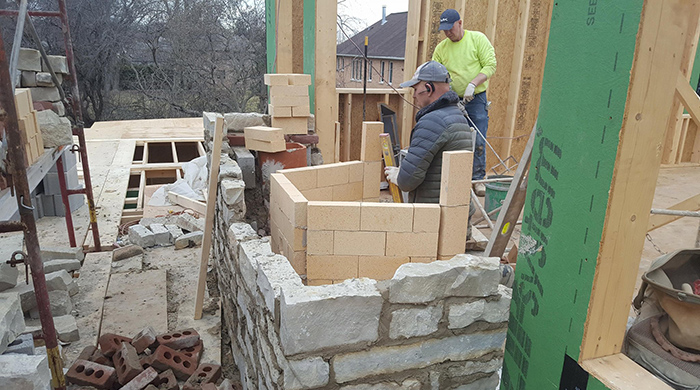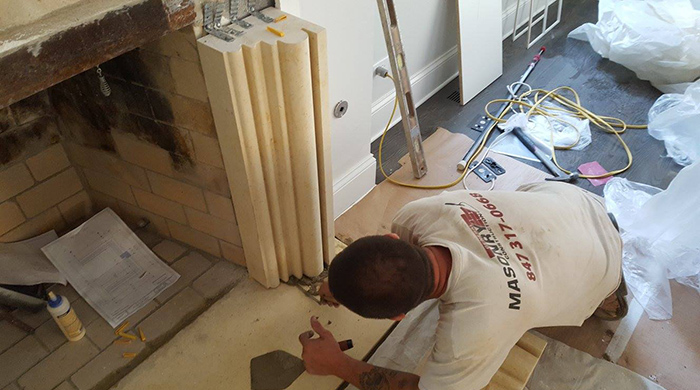Because a Masonry Fireplace’s main functions are to control fire, heat, and smoke, the inner shell is made from fireproof materials. The outer shell of the Masonry Fireplace supports the inner shell providing overall structural stability.
Some Masonry Fireplaces may have fewer or more individual parts than others but generally a masonry fireplace will consist of the following parts:
- Mortar Crown – The mortar crown is the concrete like surface at the top of your chimney. Its job is to shed water away from the flue and also keep water from entering the chimney chase.
- Flue – The flue is a vertical opening through the chimney, extending from the smoke chamber to the top of the chimney. Its primary function is to create a draft for proper ventilation, and to discharge smoke.
- Smoke Chamber – The smoke chamber is the transition area in a masonry chimney that starts directly above the damper and continues to where the first flue tile is installed. Shaped like an up-side-down funnel, smoke and hot gasses are in direct contact with the tapered smoke chamber walls as you burn your fires. The smoke chamber is a hot oven where much of the creosote accumulates and many chimney fires start.
- Smoke Shelf – A horizontal surface directly behind the throat of a fireplace to prevent downdrafts.
- Lintel – A horizontal, non-combustible member that spans the top of the fireplace opening.
- Damper – The damper is a mechanical device which opens and closes to regulate the draft and airflow to the firebox. The damper also stops heat from escaping up your chimney when the fireplace is not in use.
- Firebox – The part of the masonry fireplace where fuel is combusted.
- Hearth – The fireproof area directly in front of a fireplace. The inner or outer floor of a fireplace usually made of brick, tile, or stone.
- Ash Dump – Some masonry fireplaces will have an ash dump where ashes can be collected and removed through an ash dump fireplace door.
- Foundation – The foundation of a masonry fireplace is often referred to as a “footing” in some building codes. Codes will specify that the foundation must be a certain thickness and width with proper reinforcement.
Did you know … You can use gas logs in your Masonry Fireplace?
Masonry Fireplaces allow homeowners the versatility of warming their home with the convenience and ambiance of a gas log set as long as the fireplace and chimney are clean and in proper working condition. Gas logs simulate a true wood burning fire from the life-like ceramic fiber, concrete, or refractory logs down to the glowing ember bed, and vibrant dancing flames. Gas log burner systems can use either natural gas or propane. Natural gas is most widely used with gas log sets however some installations may require propane if natural gas is not available. Masonry fireplaces can use either vented or vent-free gas log sets.
- Vented: Vented gas log sets have a spectacular flame pattern but are decorative only. The masonry fireplace damper must remain open when a vented gas log set is in use.
- Vent-Free: Vent-free gas log sets offer high efficiency but may not be permitted in some areas (be sure to check with your local official or hearth specialty retailer before installing any unit). Vent-free gas logs are designed to operate with the damper closed.
GAS LOGS:
Gas logs simulate a true wood burning fire from the life-like ceramic fiber, concrete, or refractory logs down to the glowing ember bed, and vibrant dancing flames. Glass fireplace doors should always be used on an open front Masonry Fireplace. A good fitting glass door will help to seal off the fireplace opening and provide a valuable benefit in reducing smoke emission. Masonry Fireplace glass doors will also stop any cold air from entering the home through the chimney as well as prevent warm air from escaping the chimney, thus keeping the home warm and making the Masonry Fireplace more efficient.
FIREBACKS:
Firebacks are also designed to increase Masonry Fireplace efficiency. Fire backs are made of either steel or cast iron and sized in proportion of the fireplace. They can either be placed on the floor of the hearth and just leaned against the back wall of the fireplace or secured to the back wall with supporting braces to keep them from sliding. Firebacks cut down on heat loss by absorbing heat from the wood burning fire and radiating it back into the room and instead of allowing it to escape.
FIREPLACE INSERT
If your home has an existing Masonry Fireplace, a fireplace insert is an easy, attractive way to breathe new life into it and transform it into an efficient, warm, entertaining fireplace. Fireplace inserts are special types of wood stove and are specifically designed to fit into the firebox of the existing fireplace where the logs would normally go. This allows the fireplace insert to use the fireplace flue to vent smoke and other by-products of combustion.
If your home has an existing Masonry Fireplace, a fireplace insert is an easy, attractive way to breathe new life into it and transform it into an efficient, warm, entertaining fireplace. Fireplace inserts are special types of wood stove and are specifically designed to fit into the firebox of the existing fireplace where the logs would normally go. This allows the fireplace insert to use the fireplace flue to vent smoke and other by-products of combustion.
How to make a Masonry Fireplace energy efficient
Although newer Masonry Fireplace models have come a long way since the days when they provided more ambiance than heat and are more energy efficient than they used to be, the fact remains that an open masonry fireplace is hands down the least efficient wood burning fireplace out there. Despite their popularity, one setback of traditional fireplace construction is that approximately 90 percent of the heat from burning wood goes right up the chimney. Masonry Fireplaces have actually been proven to be a heat loss since heated air is allowed to escape out the chimney. A damper can help partially solve this problem however the damper must remain open all night while you sleep so even as the wood burning fire dies down, warm air will still escape the chimney throughout the night. Masonry Fireplaces can be made more energy efficient with the following fireplace accessories.







